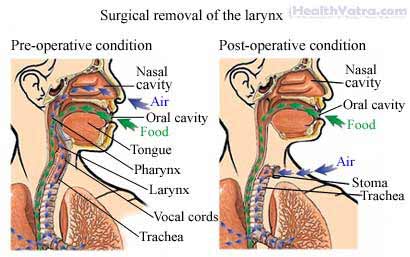Definition
This is surgery to remove the larynx (voice box). This is usually done to treat cancer. Depending on the extent of the cancer, a partial laryngectomy may be possible.

Reasons for Procedure
Laryngectomy is done to treat cancer of the larynx. This surgery may also be done to treat damage of the larynx due to trauma.
Possible Complications
If you are planning to have laryngectomy, your doctor will review a list of possible complications, which may include:
- Infection
- Breathing difficulties
- Excessive swelling or bleeding
- Injury to the trachea (windpipe) or esophagus
- Blood clots
- Anesthesia-related problems
- Saliva leaking out to the skin (saliva fistula)
- Inability to speak or aphonia
- Cancer occurs again
Some factors that may increase the risk of complications include:
- Pre-existing medical condition
- Advanced age
- Obesity
- Smoking
- Previous surgical procedure to the larynx
- Prior radiation or chemotherapy
- Poor nutrition
- Diabetes
Be sure to discuss these risks with your doctor before the surgery.
What to Expect
Prior to Procedure
Your doctor may do the following:
- Physical exam
- Laryngoscopy —the use of a long, thin, lighted tube (laryngoscope) to examine the larynx
- Radiation therapy—to treat cancer
Leading up to your surgery:
- Talk to your doctor about your medicines. You may be asked to stop taking some medicines up to one week before the procedure, like:
- Anti-inflammatory drugs (eg, aspirin )
- Blood thinners, like clopidogrel (Plavix) or warfarin (Coumadin)
- Also talk to your doctor about ways to restore speech, such as:
- Tracheoesophageal puncture
- Hand-held speech aids
- Eat a light meal the night before the surgery. Do not eat or drink anything after midnight.
Anesthesia
General anesthesia will be used. It will block any pain and keep you asleep through the surgery. It is given through an IV in your hand or arm.
Description of the Procedure
The doctor will make a cut in the skin on your neck. He will divide the muscles that are attached to the larynx. The larynx and surrounding tissue will then be removed. Sometimes, a partial laryngectomy will be done. In this case, the doctor will remove the tumor and only part of the larynx. If you have this type of surgery, you may retain some normal speech and more of your normal swallowing function.
A stoma (hole) will be created through the skin in the neck. Next, the trachea will be connected to the opening. This will enable you to breathe through the hole. In some cases, the doctor will insert a tracheostomy tube. This tube, which fits into the stoma, will act as an airway, helping you to breathe. The doctor will insert drainage tubes to drain blood and fluid. Lastly, the muscles and skin will be brought together and closed with stitches or clips.
How Long Will It Take?
5-9 hours
How Much Will It Hurt?
You will have pain while recovering, but your doctor will give you pain medicine.
Average Hospital Stay
This surgery is done in a hospital setting. The usual length of stay is 7-14 days. Your doctor may choose to keep you longer if complications arise.
Post-procedure Care
At the Hospital
While you are recovering at the hospital, you will:
- Have an oxygen mask over the stoma.
- Be given nutrition through an IV tube in your vein or a feeding tube. A speech pathologist or doctor will assess your ability to swallow. Depending on the results, you will progress to soft foods.
- You may also need to wear boots or special socks to help prevent blood clot formation in your legs
- Be instructed to:
- Use a call bell and message board to communicate.
- Keep the head of your bed raised.
- Move your legs while in bed to increase circulation.
- Learn to care for your stoma and tracheostomy tube, which includes:
- Using a mist hood over the stoma
- Keeping water out of the stoma
- Covering the stoma with a shower hood when showering
- Suctioning secretions
- Have the drains removed in about five days. The stitches will be removed in about one week.
At Home
When you return home, do the following to help ensure a smooth recovery:
- Be sure to follow your doctor’s instructions .
- For about six weeks, avoid lifting heavy objects and doing strenuous activity.
- Participate in a speech rehabilitation program. You will need to learn how to speak again. The program may involve speaking by:
- Swallowing air and expelling it (esophageal speech)
- Using an electronic device (artificial larynx)
- Installing a valve in the stoma to allow air from the lungs to reach the esophagus (tracheoesophageal speech)
The throat tissue will heal in about 2-3 weeks. Complete recovery will take about a month. You may notice a reduction in your sense of taste and smell. You will continue to use the stoma for breathing.
Most patients are able to return to their jobs and past activities, except for swimming. Ask your doctor about when it is safe to shower, bathe, or soak in water.
Joining a support group may help you to cope with the surgery.
Call Your Doctor
After you leave the hospital, contact your doctor if any of the following occurs:
- Signs of infection, including fever and chills
- Redness, swelling, increasing pain, excessive bleeding, or any discharge from the incision site
- Nausea and/or vomiting that you cannot control with the medicines you were given after surgery, or which persist for more than two days after discharge from the hospital
- Pain that you cannot control with the medicines you have been given
- Cough, shortness of breath, or chest pain
- Headache, muscle aches, or dizziness
- Tracheostoma is getting smaller
- Saliva leaking through your incision
- New, unexplained symptoms
In case of an emergency, call for medical help right away.
